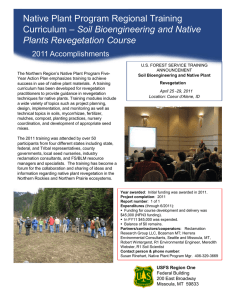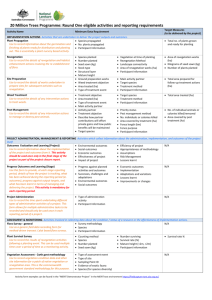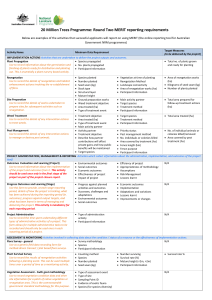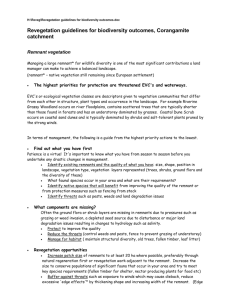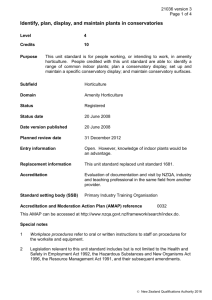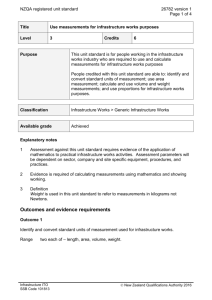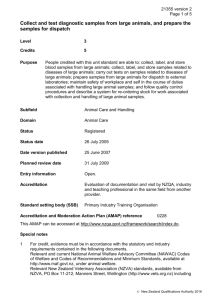21033 Revegetate indigenous plant areas
advertisement
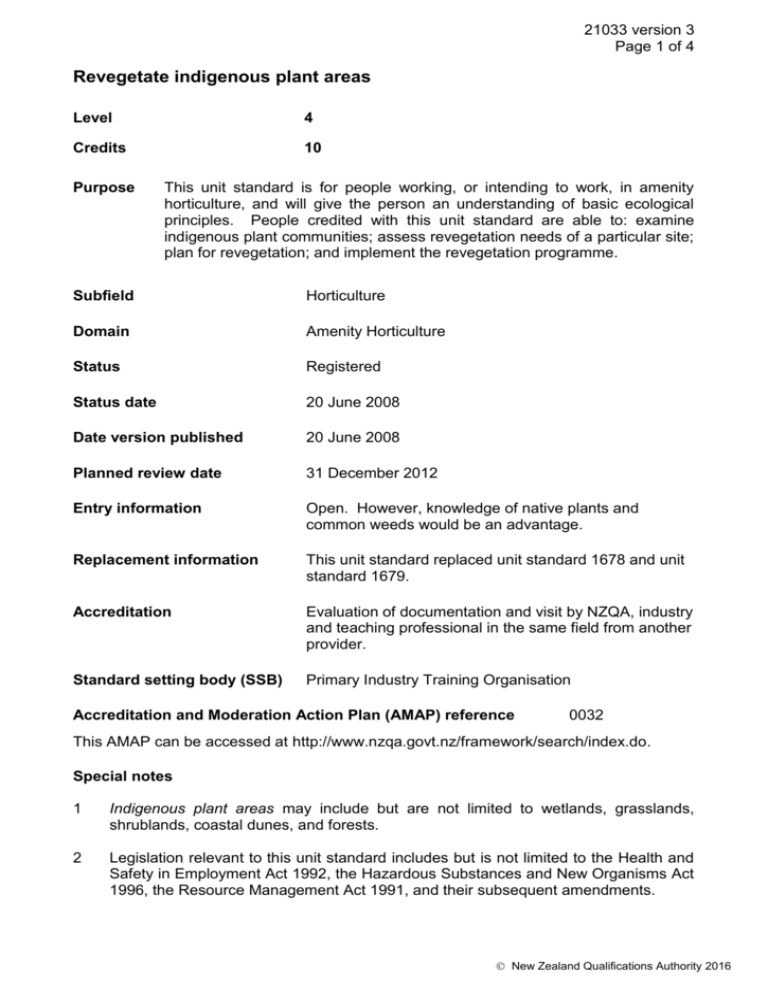
21033 version 3 Page 1 of 4 Revegetate indigenous plant areas Level 4 Credits 10 Purpose This unit standard is for people working, or intending to work, in amenity horticulture, and will give the person an understanding of basic ecological principles. People credited with this unit standard are able to: examine indigenous plant communities; assess revegetation needs of a particular site; plan for revegetation; and implement the revegetation programme. Subfield Horticulture Domain Amenity Horticulture Status Registered Status date 20 June 2008 Date version published 20 June 2008 Planned review date 31 December 2012 Entry information Open. However, knowledge of native plants and common weeds would be an advantage. Replacement information This unit standard replaced unit standard 1678 and unit standard 1679. Accreditation Evaluation of documentation and visit by NZQA, industry and teaching professional in the same field from another provider. Standard setting body (SSB) Primary Industry Training Organisation Accreditation and Moderation Action Plan (AMAP) reference 0032 This AMAP can be accessed at http://www.nzqa.govt.nz/framework/search/index.do. Special notes 1 Indigenous plant areas may include but are not limited to wetlands, grasslands, shrublands, coastal dunes, and forests. 2 Legislation relevant to this unit standard includes but is not limited to the Health and Safety in Employment Act 1992, the Hazardous Substances and New Organisms Act 1996, the Resource Management Act 1991, and their subsequent amendments. New Zealand Qualifications Authority 2016 21033 version 3 Page 2 of 4 3 Work may involve exposure to chemical, dangerous, or hazardous substances. Safety procedures are observed in accordance with NZS 8409:2004 Management of Agrichemicals, available from Standards New Zealand http://www.standards.co.nz. 4 Workplace procedures refer to oral or written instructions to staff on procedures for the worksite and equipment. Elements and performance criteria Element 1 Examine indigenous plant communities. Performance criteria 1.1 A plant community is examined in terms of plant associations and the main plant species present. Range 1.2 may include but is not limited to – emergent, subcanopy, understorey, forest floor. The relationships between community members are explained. Range nutrient cycling, food chains, symbiosis, parasites, saprophytes. 1.3 The process of plant succession is outlined, based on a plant community. 1.4 The site conditions influencing a natural, or semi-natural, plant community are identified. Range 1.5 may include but is not limited to – soil, climate, topography, plant and animal pests, human influences. A modified example of a natural plant community is examined and reason(s) for degradation identified. Element 2 Assess revegetation needs of a particular site. Performance criteria 2.1 Site conditions that may influence revegetation are analysed in accordance with workplace procedures. Range 2.2 may include but is not limited to – soil, topography, climate, existing vegetation, animal effects, human effects. Goals of revegetation are identified in accordance with workplace procedures. Range may include but is not limited to – enhanced wildlife habitat, biodiversity, enhanced amenity values. New Zealand Qualifications Authority 2016 21033 version 3 Page 3 of 4 2.3 Site improvements needed are identified in accordance with workplace procedures. Range 2.4 may include but is not limited to – weed control, animal control, shelter, perimeter, protection. The selected site is compared with a less degraded community of the same type in accordance with workplace procedures. Range may include but is not limited to – site conditions, improvements, limiting factors. 2.5 Local authorities and community, as appropriate, are consulted on the revegetation programme in accordance with workplace procedures. 2.6 Plant species requirements are identified and source of local provenance plants is identified. 2.7 Possible revegetation strategies for the site are identified. Range may include but is not limited to – planting, encouraging natural regeneration with minimal planting. Element 3 Plan for revegetation. Performance criteria 3.1 A revegetation strategy is selected and a programme for site preparation, revegetation, and maintenance is documented. 3.2 The supply of plant material is organised to suit revegetation plan. Range may include but is not limited to – provenance, propagation method, plant type, species, container type, time. Element 4 Implement the revegetation programme. Performance criteria 4.1 The site is prepared for revegetation in accordance with the programme. Range 4.2 may include but is not limited to – weed control, pest control, shelter, fencing, preparation of planting positions. Plants are positioned and planted to facilitate plant survival. New Zealand Qualifications Authority 2016 21033 version 3 Page 4 of 4 4.3 Site is monitored and maintained to facilitate plant survival. Range may include but is not limited to – weed control, pest control, releasing plants, plant health, fencing, control of vandalism, public information. Please note Providers must be accredited by NZQA, or an inter-institutional body with delegated authority for quality assurance, before they can report credits from assessment against unit standards or deliver courses of study leading to that assessment. Industry Training Organisations must be accredited by NZQA before they can register credits from assessment against unit standards. Accredited providers and Industry Training Organisations assessing against unit standards must engage with the moderation system that applies to those standards. Accreditation requirements and an outline of the moderation system that applies to this standard are outlined in the Accreditation and Moderation Action Plan (AMAP). The AMAP also includes useful information about special requirements for organisations wishing to develop education and training programmes, such as minimum qualifications for tutors and assessors, and special resource requirements. Comments on this unit standard Please contact the Primary Industry Training Organisation http://www.primaryito.ac.nz if you wish to suggest changes to the content of this unit standard. New Zealand Qualifications Authority 2016
